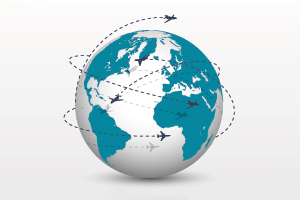Through a Crystal Ball Darkly: What Does 2018 Smell Like?
(Year-End 'Big Blog' 2017)
A New Beginning.........or Just More of the Same?
Logically, there is no reason to view the end of one year and beginning of another as a reason to expect a change in human behaviour. Other than ephemeral New Year resolutions to lose weight, spend more time in the gym, and eat healthily, people don't change their behaviour dramatically, and certainly not their attitudes and tastes, on January 1st. So why should this make any difference to travel patterns? It doesn't. But, like New Year resolutions, it's a convenient milestone to pause the treadmill, take stock and assess what the future holds. Macroeconomic conditions, investment in infrastructure, and improved access, will drive change in 2018 far more than any shift in travellers' tastes.
The trends identified below are not earth-shaking revelations about radical changes in human desire. Rather, they are a continuation of what has been going on for some time, overlaid with an analysis of external impacts, which might affect where and how people look, book and travel in the months ahead.
Nor does this analysis of trends for 2018 pretend to be comprehensive. It is a snapshot of some of the things that might shape travel behaviour and influence the popularity of different destinations over the next year – a basket of insights gleaned from a variety of sources including: last months’ World Travel Market, conversations with tourism professionals, media reports, and the general ‘smell of the marketplace’ based on years’ of experience, which could of course turn out to be seriously impaired by years of olfactory overload or overpowered by stronger odours emanating from economically momentous events.
Nevertheless, here are some ‘future smells’, which wafted out of the cauldron of market intelligence over the last few months. In highlighting things to watch out for in 2018, I have looked at three areas: global movements – ‘the big stuff’; new destinations tipped for growth – ‘mighty mice’; and delivery channels – ‘connecting wires’. I hope this might prove to be an appetising whiff of the future.
Global Movements – ‘The Big Stuff’

In spite of various local problems and international concerns, globally the story remains one of confidence and growth.
Terrorism and Tourism: Tourism continues to grow worldwide, in spite of more widely distributed terrorist incidents and growing security concerns. Terrorism remains the number-one concern for British holidaymakers, far higher than other travel worries. Germans too are more concerned about travelling to destinations they perceive to be safe. However, with notable exceptions of Middle Eastern, North and East African beach destinations, this appears not to have dampened the demand for travel from Europe's two giant tourism-producing markets, UK and Germany. The disproportionate suffering of some areas, particularly sun destinations such as Egypt, Tunisia and, to a lesser extent, the Kenyan coast, has boosted traditional Mediterranean sun destinations. This is likely to continue into next year. And, with demand compressed into fewer destinations, deals are likely to be few and far between in 2018.
Isolated terrorist attacks in cities such as London, Brussels, Barcelona and New York, while sometimes depressing immediate travel, appear to have had no long term impact on visitor numbers. Visitor arrivals in Spain reached an all-time high of 10,510,331 in July. Perhaps the greatest impact was felt by Paris, which lost c. 1.5 million visitors after the 2015 terrorism incidents and has taken 15 months to experience a resurgence. But Paris too is now enjoying a 10-year visitor high.
Asia and the Growth of China: Asia continues its remarkable success story. The rise of China, the world’s largest outbound travel market, still dominates many conversations about Asian tourism. Intra-regional tourism still accounts for c.80% of international arrivals in Asia. China may still be the world’s largest tourism destination, in terms of arrivals, but the wider region is also booming. Tourism to Japan reached a record high in the second quarter of 2017, with a 21.1% increase over 2016 for the April-June period. An interesting trend is the rise of the Chinese independent traveller. The clichéd image of Chinese travelling exclusively in groups for sightseeing and shopping is out of date. More and more younger Chinese are travelling independently, seeking immersive experiences and adventure. This trend will accelerate in 2018.
The Trump Slump: The c.4% drop in international visitors to the USA in the first half of 2017 seems to have partly rallied. But by Sept 2017 inbound visitors to the USA were still showing a 1.4% decline on the previous year. Travel to the USA from Europe has dropped by 2.3% and from Asia-Pacific by 3.8%. As these two regions together represent almost two thirds of US inbound tourism, against a global tourism growth of 4.6%, this has to be a concern going forward into 2018. The reasons are likely to be more complex than the media-attributed moniker implies. Certainly sterling’s weakness against the dollar is likely to have some effect, as the UK is one of the USA’s biggest tourism markets. So too is the travel ban on seven Muslim-majority countries likely to have contributed towards the drop in visitors from the Middle East by almost one third. While the USA is a hardy perennial, there are few signs of change on the horizon in the circumstances influencing this decline.
The Brexit Bump: Much talked about at the World Travel Market, Brexit was a tale of winners and losers. The drop in sterling against major currencies after the Brexit vote, especially against the Euro and the dollar, is a worry for many countries that depend on visitors from the world’s 4th largest outbound tourism market, the UK; but British hotels and inbound tour operators were rubbing their hands with glee at the prospect of more visitors taking advantage of lower prices in the UK. With a further decline in sterling predicted for 2018 by as much as 7% against the Euro, European destinations will need to seek to fill the shortfall from elsewhere.
The Caribbean Cramp: Sadly, the Caribbean was hit particularly badly by three major hurricanes, Harvey, Irma and Maria in relatively quick succession. 2017 was by far the costliest season on record, with an estimated total of over $369.76 billion damage. But this is a resilient region and it is mostly expected, as ever, to bounce back in 2018, thanks to the spirit of the people, commitment of businesses and emotive marketing campaigns such as Virgin and UB40s reprise of ‘Come Back Darling’. Like cramp, it’s very painful, but won’t last forever.
New Destinations Tipped for Growth – ‘Mighty Mice’

Every year, like hormonal teenagers, some destinations put on a growth spurt. Lesser-known places burst on to the travel map and begin to bloom. They tend to be smaller places that can still offer authentic experiences, are perceived as remote and less-travelled, which offer a relatively unspoilt natural environment and opportunities for adventure – the escapist idyll.
My prediction is that Cabo Verde, the Azores, Albania and Northern Iceland will be 2018’s hormonal teenagers. With a faster growth rate than many countries, this will be the year they embed themselves in travellers’ consciousness as destinations worth visiting. Factors in their favour are: affordable flight access is improving and hotel infrastructure increasing in Cabo Verde, which offers great windsurfing, kitesurfing and winter sun; the Azores ticks the remote, natural appeal box; international flights have started into Akureyri, opening up the stunning north of Iceland, with a greater chance of seeing the northern lights; and Albania offers a mix of so far un-touristed mountains and sea. I walked over the fabulous “Accursed Mountains” from Montenegro into Albania several years ago – a great way to enter the country. But, if you don’t have the time, several European airlines now offer reasonable fares into Tirana.
Other established destinations, particularly those offering stunning scenery and wilderness adventure, such as Scotland, Norway, Namibia, Canadian and US national parks, Alaska and rural Japan are, I believe, likely to see above average growth in 2018. The challenge for these destinations will be to manage both visitor numbers and the destination experience. As we live increasingly in cities, destinations that offer an antidote to the frenetic pace of urban life are becoming more sought after. And, as they become scarcer, places that offer an escape to nature and solitude will command a premium.
Delivery Channels – ‘Connecting Wires’

Information, booking and access remain critical in terms of connecting people to places. But they are changing fast: social media is changing both how we source information – from conversations with ‘real’ people who’ve been there, as opposed to destination websites and travel agents who are selling the trip; artificial intelligence (AI) is enabling us to experience a destination long before we visit; and no-frills airlines are making it cheaper to get there. This is just as well, as tourism taxes are likely to rear their heads as many more cities and countries seek new sources of funding to maintain their infrastructure and promote their destination.
Long-Haul No-Frills Boom: Norwegian, Wow and Air Asia have shown that no frills budget flying need not be restricted to short haul. Assuming they can keep making the figures stack up, expect a boom in long-haul budget airlines, or at least routes and services next year.
Pilotless Aircraft: Driverless cars may be well on the way; but pilotless aircraft are in the pipeline too, although not as soon as 2018. Taking ‘no frills’ to a new level, this could solve the problem of the worldwide shortage of pilots. A robotic pilot has already successfully flown and landed a Boeing 737…….simulator! It’s likely to be passenger confidence, not technological constraints, which will determine whether this idea flies. Resistance to pilotless aircraft seems more surmountable today than any challenge to Lord Kelvin’s (President of Royal Society) claim might have been in 1895 that “heavier-than-air flying machines are impossible”.
Social media: Years ago, it was predicted that websites and Google would kill off destination brochures; and more recently that social media would kill off websites. But they all stubbornly persist to varying degrees. Perhaps social media has not dealt the coup de grace to brochures and websites, because of the prevalence of fake sites and insecurity about the reliability of information sources. However, peer-to-peer information-sharing about places to visit is growing, not least via messaging apps. Messaging apps are likely to see considerable growth in 2018 as channels for seeking information on places to visit from people who’ve been there or live there, in preference to those, such as tourist boards, whose job is to promote the place.
Distribution, booking and payment: 2018 is likely to be the year we will see whether the travel industry adopts cryptocurrencies, such as Bitcoin, and blockchain payment systems. The security and efficiency of blockchain technology may be appealing, but will businesses invest in developing these systems? TUI has already taken tentative steps towards migrating some of its hotel data infrastructure on to a private blockchain, but cost and trust will be the deciding factors for businesses.
Always an early adopter, Virgin accepts payment in Bitcoin, as does Expedia and many other businesses. However, with the phenomenal rise in value of Bitcoin this year, the consequent fear of a Bitcoin bubble may cause many companies to hold off accepting this digital currency for some time yet. Nevertheless, just like internet shopping was once treated with mistrust, it seems likely that cryptocurrencies will become mainstream, if not in 2018, probably by 2019.
Sharing economy: 2017 was the year when we got real about the so-called ‘sharing economy’. Far from being driven by philanthropic motives, most businesses in the ‘sharing economy' space were recognised as using a digital platform to conduct their business, which was as much about sharing as any supermarket transaction. Some dirty digital linen is still being washed and the prospect of having their cake and eating it reduced: the outcome of Uber’s appeal against its ban in London is awaited, and the European Court of Justice has just decreed Uber is a transport company, not an uninvolved intermediary; and cities from San Francisco to London, Paris and Reykjavik have imposed limits on short-term property rental, in order to prevent distortion of the housing market and ensure a level playing field in terms of tax and regulations. As the poster child for short-term lets, Airbnb has perhaps borne the brunt of such criticism; but, like Uber, its sheer size and rate of growth has demonstrated there is a strong demand for such services. City and national governments may get tougher on this type of business next year and put them more on a level playing field with their traditional competitors, in terms of tax, safety, and employment regulations. Nevertheless ‘travel disrupters’, which bring the business closer to the customer, are only likely to grow in 2018 and beyond, because they are serving a rapidly growing demand. Just as the Michigan Savings Bank President, advising Henry Ford's lawyer not to invest in the Ford Motor Co. in 1903, said “the horse is here to stay but the automobile is only a novelty—a fad”, so are those who resist such change likely to find themselves on the wrong side of history.
Conclusion: 2018 Looks the Same, but Different

So, as ever, the crystal ball is cloudy. The only thing certain about the future is that it’s uncertain. Nevertheless, there is some clarity on travellers’ motives and behaviour, which enables us to make a reasonable guess at which destinations will be hot and which not. We can foresee a growth in 2018 of no-frills long haul travel, greater demand for places that offer space, tranquillity, stunning scenery, and wilderness adventure, and opportunities for destinations that have not yet been discovered. Less certain is the pace at which technology – from artificial intelligence to driverless vehicles and cryptocurrencies – will be adopted.
I suspect, in 5-10 years’ time, we will look back on 2018 and wonder what all the fuss was about, as we relax with an instant mojito in our driverless car en route to our town’s local air station to board our pilotless plane, which we pay for with a tap on the cryptochip embedded in our forearm which debits our annual travel quota, heading to one of the few destinations that still has trees, wild animals and fresh air. Or perhaps, as millennials will hold the reins of purchasing power, foreign holidays will go out of fashion, and breaks will be taken at home with friends playing high octane, virtual reality games across exotic virtual reality destinations in the comfort of their home entertainment centres, as planes rust in the desert and once booming resorts revert to their original state, waist-deep in vegetation and home to a burgeoning wildlife population.................Either way, 2018 will feel positively mundane by comparison.


